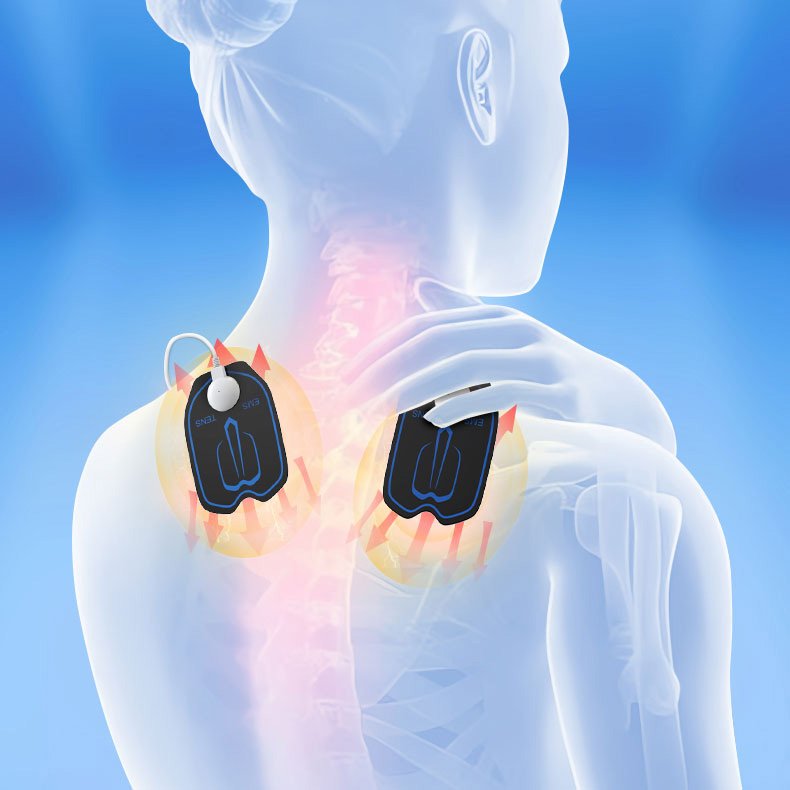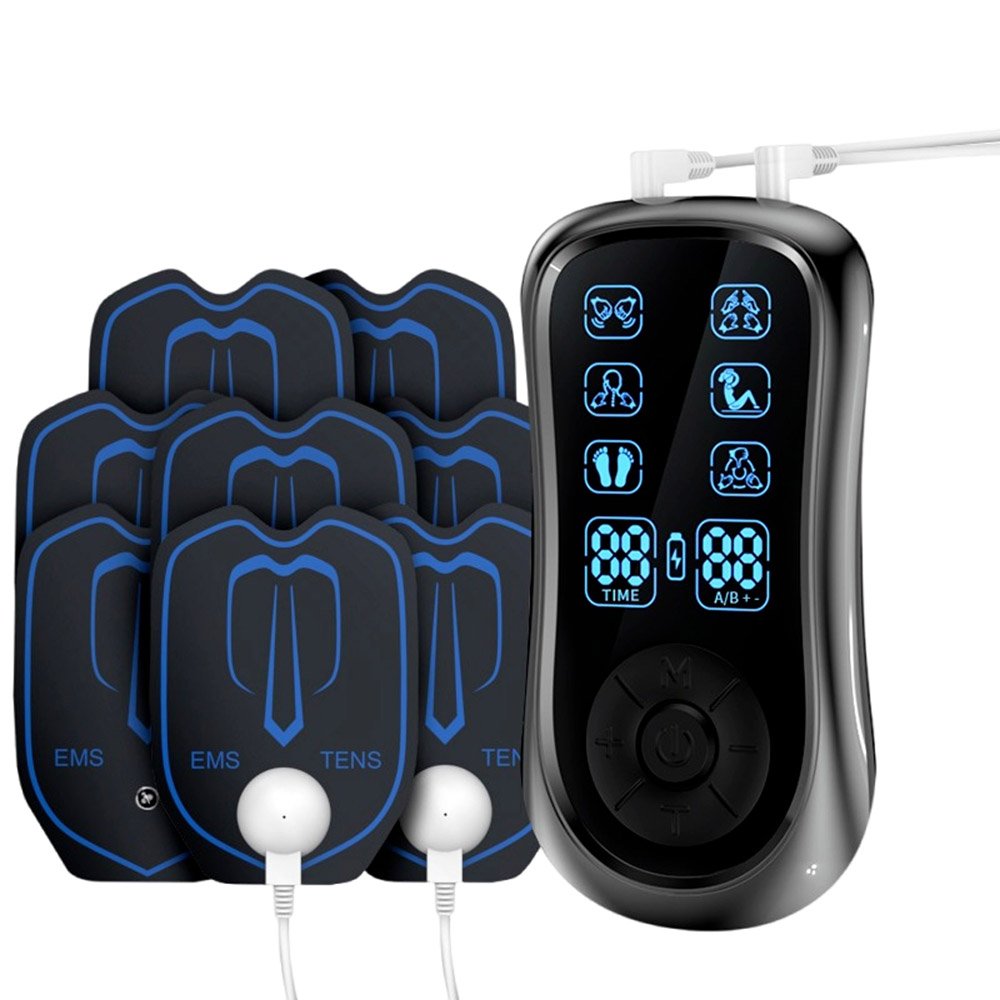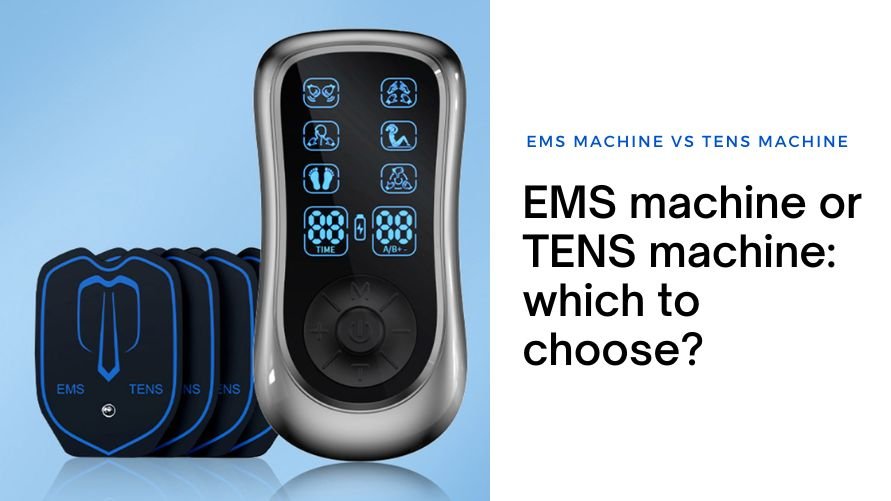Table of Contents
What is TENS(Transcutaneous Electrical Nerve Stimulation)?
Transcutaneous Electrical Nerve Stimulation (TENS) is a non-invasive therapy that involves the use of low-voltage electrical currents to provide pain relief. It is a commonly used method for managing acute and chronic pain.

What is EMS(Electrical Muscle Stimulation)
Electrical Muscle Stimulation (EMS), also known as neuromuscular electrical stimulation (NMES) or electromyostimulation, is a technique that uses electrical impulses to stimulate muscle contractions. It involves the use of electrodes placed on the skin over the targeted muscles, which are then connected to a device that generates electrical currents.

The electrical currents produced by an EMS device mimic the natural electrical signals sent by the nervous system to stimulate muscle contractions. These contractions can help to strengthen and tone muscles, improve circulation, increase range of motion, and enhance muscle recovery.
EMS is commonly used in various settings, including rehabilitation and physical therapy clinics, sports training, and fitness programs. It is often employed as a complementary or adjunct therapy to traditional exercise and training methods. Some individuals also use EMS devices for aesthetic purposes, such as muscle toning or enhancing muscle definition.
How EMS and TENS machines work
A TENS machine, also known as a TENS unit or a nerve stimulator. The TENS unit typically consists of a small battery-operated device that generates the electrical currents, as well as leads and electrodes for application to the skin. TENS machines work by using electrical stimulation to modulate pain signals and provide pain relief. The exact mechanism of action is not fully understood, but there are a few proposed theories:
- Gate Control Theory: According to this theory, TENS stimulation activates large sensory nerve fibers, which transmit non-painful signals to the brain. These signals essentially “close the gate” to prevent the transmission of pain signals from smaller nerve fibers. The non-painful signals are thought to compete with the pain signals, reducing their perception.
- Endorphin Release: TENS may stimulate the release of endorphins, which are natural pain-relieving substances produced by the body. Endorphins can bind to opioid receptors in the brain and spinal cord, reducing pain perception.
- Central Nervous System Modulation: TENS may also modulate the central nervous system, including the spinal cord and brain, by influencing the transmission and processing of pain signals. It may affect the release of neurotransmitters involved in pain signaling, leading to pain relief.
When the TENS machine is activated, it generates low-voltage electrical currents that are delivered through the electrodes placed on the skin. These electrical impulses stimulate the underlying nerves in the area, leading to various physiological effects:
- Sensory Stimulation: TENS can activate sensory nerves, producing tingling or vibrating sensations at the electrode site. These sensations help to distract from the pain and provide a more pleasant sensation.
- Muscle Stimulation: TENS can also stimulate the muscles in the area being treated. This can help to relax muscle spasms, improve blood flow, and promote muscle healing.
The intensity, frequency, and duration of the electrical impulses can be adjusted based on individual preferences and the guidance of a healthcare professional. It is important to follow the instructions provided by the manufacturer and consult with a healthcare professional to ensure safe and effective use of the TENS machine.
An EMS machine works in more or less the same way. While EMS machines primarily aim to stimulate muscle contractions, they can also help relax muscles indirectly. Here’s how EMS machines can contribute to muscle relaxation:
- Muscle Activation and Fatigue: When the EMS machine stimulates muscle contractions, it can help activate and engage the muscle fibers. This activation can lead to an increase in blood flow to the muscles and the removal of waste products, which may contribute to muscle relaxation and alleviate muscle tension.
- Improved Circulation: The electrical impulses delivered by the EMS machine can enhance blood circulation in the targeted muscles. Improved circulation can provide oxygen and nutrients to the muscles, promoting relaxation and aiding in the removal of metabolic byproducts that can contribute to muscle soreness and tension.
- Muscle Recovery and Repair: EMS machines can be used as a part of muscle recovery and rehabilitation programs. By promoting muscle contractions, EMS can help to maintain muscle mass, prevent muscle atrophy, and facilitate the repair and regeneration of muscle tissue. This can contribute to overall muscle relaxation and recovery.
- Decreased Muscle Spasms: EMS can potentially reduce muscle spasms or involuntary muscle contractions. The controlled electrical stimulation provided by the EMS machine can interrupt the abnormal electrical activity in the muscles that contribute to spasms, helping to restore normal muscle function and relaxation.
It’s important to note that the specific EMS settings, such as intensity, duration, and frequency, can influence the impact on muscle relaxation. Adjusting these settings based on individual comfort and guidance from healthcare professionals or trained therapists is crucial to ensure safe and effective muscle relaxation through EMS therapy.
EMS or TENS machines: which to choose?
The choice between EMS (Electrical Muscle Stimulation) and TENS (Transcutaneous Electrical Nerve Stimulation) machines depends on your specific needs and goals. Let’s compare the two:

Purpose and Targeted Area:
EMS machines primarily focus on muscle stimulation and contraction. They are commonly used for muscle strengthening, endurance improvement, and muscle recovery in fitness, sports training, and rehabilitation settings.
TENS machines primarily target pain relief by stimulating nerves. They are commonly used to manage acute and chronic pain conditions, such as back pain, arthritis, and neuropathic pain.
Mechanism of Action:
EMS machines deliver electrical impulses that directly stimulate the muscles, causing them to contract. The goal is to engage and strengthen the muscles.
TENS machines deliver electrical impulses that target nerves, aiming to modulate pain signals and provide pain relief.
Electrode Placement:
EMS machines typically require electrode placement directly on the muscles or muscle groups that you want to stimulate.
TENS machines require electrode placement near the area of pain or along the path of the affected nerves.
Sensations and Comfort:
EMS stimulation can cause noticeable muscle contractions and may feel intense or uncomfortable at higher intensity levels. However, the intensity can be adjusted to individual tolerance.
TENS stimulation generally produces tingling or vibrating sensations without causing muscle contractions. The intensity can also be adjusted to suit comfort levels.
Treatment Goals:
EMS is commonly used for muscle strengthening, improving muscle tone, enhancing athletic performance, and supporting rehabilitation after muscle injuries.
TENS is primarily used for pain management, reducing pain intensity, and promoting relaxation of painful muscles.
It’s important to note that both EMS and TENS machines have their specific uses and benefits. In some cases, a combination of both may be appropriate. Consulting with a healthcare professional or therapist can help determine which option is most suitable for your specific needs and conditions. They can provide guidance on proper usage, settings, and treatment protocols to ensure optimal results and safety.

